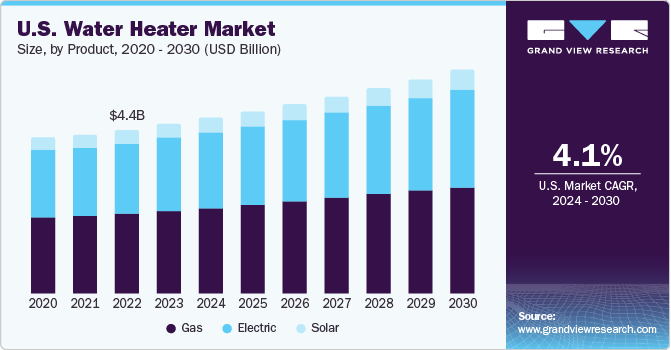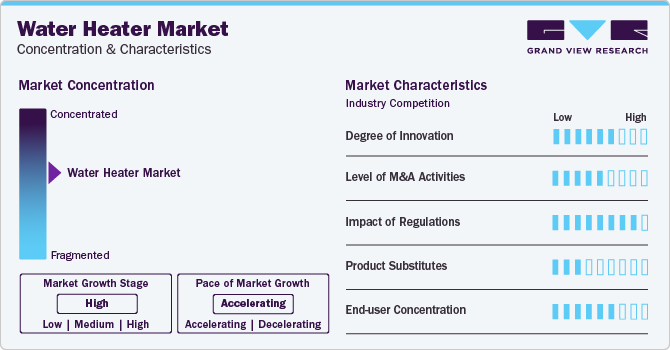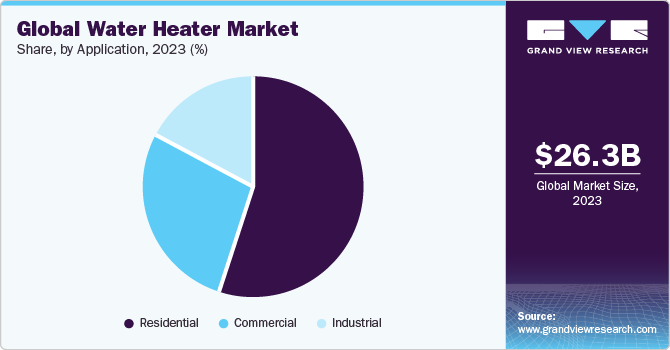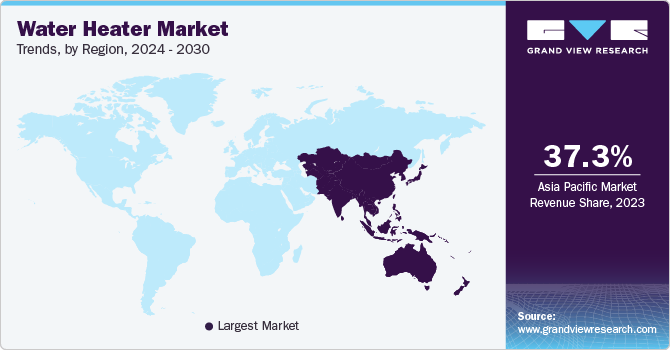- Home
- »
- Advanced Interior Materials
- »
-
Water Heater Market Size, Share & Trends Report, 2030GVR Report cover
![Water Heater Market Size, Share & Trends Report]()
Water Heater Market Size, Share & Trends Analysis Report By Product (Electric, Solar, Gas), By Technology, By Capacity, By Application (Residential), By Region, And Segment Forecasts, 2024 - 2030
- Report ID: GVR-4-68038-824-4
- Number of Report Pages: 152
- Format: PDF, Horizon Databook
- Historical Range: 2018 - 2023
- Forecast Period: 2024 - 2030
- Industry: Advanced Materials
Water Heater Market Size & Trends
The global water heater market size was estimated at USD 29.26 billion in 2023 and is anticipated to grow at a Compound Annual Growth Rate (CAGR) of 4.7% from 2024 to 2030. This growth is owing to the increasing hot water demand from various residential applications, including washing, bathing, cleaning, and cooking.

With the rise in population, urbanization, and changing lifestyles, the demand for hot water is increasing rapidly. Consumers are increasingly becoming aware of the environmental impact of traditional water heaters and are opting for more energy-efficient and sustainable options. Technological advancements and innovative product offerings are also contributing to market growth.
Market Concentration & Characteristics
The market growth stage is medium and the pace of its growth is accelerating. The market is characterized by a high degree of competition owing to the various technologies used for water heaters and a large number of manufacturers at the global level.

The market is heavily influenced by government regulations and policies related to energy efficiency and carbon emissions. Further, technological advancements, such as the integration of smart technologies and the Internet of Things (IoT) in water heaters, are transforming the use of water heaters. The increasing focus on energy efficiency and sustainability is driving the demand for eco-friendly water heaters.
Over the past few years, water heater manufacturers have incorporated smart technology that allows users to interact with the system in several ways. For instance, by using an app on a smartphone or tablet, users can adjust the water temperature, check the heater’s status, and shut down the unit from any location. Smart water heaters help prevent heater damage due to water by shutting down the system as soon as a leak is detected.
The market is navigating a landscape characterized by increased regulatory attention, with governments globally implementing stringent standards and guidelines. These regulations focus on ensuring product safety, performance efficacy, and environmental impact. Consumer preferences and purchasing behavior, such as the preference for energy-efficient and cost-effective water heaters and the increasing demand for online purchase options.
The trend toward energy efficiency is driven by both increasing consumer demand and favorable government regulations. Energy and environmental regulations are increasingly influencing the adoption of energy-efficient appliances as well as building resources. Energy efficiency has become a priority for a large number of contractors, builders, and engineers who support and work on green projects. Moreover, in the U.S., green solutions and sustainability are gaining importance as various states and cities across the country are implementing regulatory policies to reduce greenhouse gas emissions and energy use in buildings.
Product Insights
The electric product segment dominated the market and accounted for a share of 51.1% in 2023 owing to the rising electrification rate coupled with increased customer accessibility, mainly across the Asia Pacific and African economies. The product demand is expected to be driven by energy efficiency, greater environmental sustainability, and temperature control. Stringent government rules to reduce greenhouse gas emissions, along with a rising emphasis on reducing energy usage owing to the quick depletion of nonrenewable resources, are anticipated to boost demand for solar products.
Furthermore, increased environmental consciousness in both developed and developing nations is expected to drive product demand. Over the projection period, the expansion of pipe networks for gas distribution across various developing nations is expected to result in the widespread use of gas water heaters. Furthermore, a greater emphasis on product innovation and uniqueness is projected to boost the demand for gas water heaters, benefiting overall industry growth.
Technology Insights
The storage tank segment dominated the market in 2023 and is anticipated to show lucrative growth from 2024 to 2030 owing to the high-energy conversion potential and low maintenance requirement of the product. Furthermore, the rising number of installations in commercial and industrial applications in diverse cold locations across the world is driving product demand. Tankless products provide advantages, such as more accurate temperature control, increased energy efficiency, and greater environmental sustainability.
Rising product adoption across various business spaces due to enhanced operational benefits is expected to boost demand for these products over the projection period. The hybrid segment is expected to have significant growth owing to significant product attributes, such as offering cooling and heating from a single unit. These products use electricity to transmit heat from one location to another rather than directly generating power, making them more energy-efficient than electric products.
Capacity Insights
The 30 - 100 liters capacity segment is anticipated to have lucrative growth from 2024 to 2030 owing to the high application aptness across residential as well as various commercial establishments, including banks, healthcare, hotels, government institutions, and shopping complexes. Rapid urbanization, coupled with continuous migration to cities, is expected to boost demand for the 100-250-liter segment. The product's availability in numerous capacities addresses several client demands, such as its use in kitchens, swimming pools, and washrooms, thus boosting market expansion.
The increased deployment of low-capacity heating systems, mostly in residential settings, is expected to drive demand for water heaters of capacity below 30 liters. Furthermore, the increasing use of storage tanks is expected to enhance the installation of water heaters with capacities of less than 30 liters in the coming years. The ability of water heaters with more than 400 liters capacity to combine heat pumps with thermal solar systems is expected to boost segment growth.
Application Insights
The residential segment is anticipated to witness lucrative growth from 2024 to 2030 owing to the rapid residential infrastructural development, rising disposable incomes, expanding gas pipe network, and increasing electrification rate across various developing countries, which are expected to drive demand for water heaters in the residential sector. The growing need for dependable, eco-friendly, and inexpensive water heating technologies, particularly in the industrial and residential sectors, is expected to drive market expansion. In addition, the capacity of water heaters to function at reduced costs, up to 75% cheaper in summer and 30% to 40% lower in winter, is expected to boost product demand during the forecast period.

Water heaters are used in various industrial applications, such as construction, food and beverage, pharmaceutical, power, and agriculture, which is anticipated to propel the industry growth. In the construction industry, these systems are useful for steam generation, freeze protection, and water heating. Furthermore, increased deployment of tankless products in commercial workplaces is expected to drive market growth.
Regional Insights
Asia Pacific dominated the global market and accounted for a share of 37.3% in 2023. The product demand in Asia Pacific is driven by the increasing availability of gas and electricity across rural areas and increasing investments in infrastructure, positive momentum in the construction industry, and industrial development in South Asian and Southeast Asian economies. In addition, the emphasis on carbon neutrality and energy-efficiency standards is expected to boost market growth.

Canada Water Heater Market
The market in Canada is driven by the rising requirement for hot water in industries and the role of water heaters in a well-established industrial infrastructure in the country.The market for condensing tankless units witnessed a significant boost with the implementation of the new NRCan (Natural Resources Canada) Amendment 15 to the Energy Efficiency requirements on January 1, 2020. The Amendment stated that all home tankless water heaters with an input of less than 200 MBH are required to use condensing technology. Minimum efficiency limits will be dependent on the maximum flow rate of the product: 0.86 UEF for less than 6.4 L/min and 0.87 UEF for more than 6.4 L/min. Steady growth of gas-fired condensing technology, which applies to both storage tanks and tankless water heaters, is expected to have a positive impact on market expansion
Germany Water Heater Market
The market in Germany is expected to witness significant growth in the coming years owing to growing product demand, especially in commercial and industrial applications. According to the Federal Ministry for Economic Affairs and Energy, around two-thirds of the buildings in the country need renovation to meet the energy efficiency targets set for a sustainable energy system. To meet the energy efficiency targets, the government is encouraging the use of energy-efficient water heaters, thereby augmenting market growth.
China Water Heater Market
The market in China is expected to witness growth in the coming years owing to the growing industrial sector. China has pledged to be carbon-neutral by 2060, owing to which the government is likely to encourage investment and innovation in the construction sector by supporting research & development and implementing obligatory CO2 emission reduction measures. Water heaters are required in cement production, mainly for cement curing. The demand for energy-efficient water heaters coupled with the growth of the cement industry is expected to boost product penetration in various industrial applications.
Brazil Water Heater Market
The market growth in Brazil is driven by the increased adoption of tankless water heaters providing features, such as inbuilt Wi-Fi, leak detection systems, and extensive communication options. The recuperating construction sector in Brazil, coupled with increasing investments in high-rise luxury apartment buildings, is expected to have a positive impact on the water heater market.
Saudi Arabia Water Heater Market
The market in Saudi Arabia is experiencing significant growth owing to the growing industrial sector. As economic activities normalize, the demand for water heaters in industrial applications is expected to witness growth. Middle Eastern countries, such as Qatar and Oman, are expected to boost oil & gas production output along with petrochemical production. With an expected increase in natural gas production, the demand for gas water heaters is likely to go up over the forecast period.
Key Water Heater Company Insights
The market is extremely fragmented with various global and regional product manufacturers releasing innovative systems and technologies. Various industry participants' strategies typically involve new product development, product upgrades, and expansions to boost market penetration and respond to the changing technical needs of the application industries. The major players form technical partnerships to innovate and develop novel product lines, therefore expanding their consumer base.
In addition, evolving consumer preferences, along with quality requirements as well as energy efficiency, are projected to offer new opportunities for key participants in the coming years. In October 2023, Voltas unveiled its line of Voltas Water Heaters, which are now accessible through various online channels. This strategic move signifies Voltas' entry into the market and underscores the company's commitment to becoming a comprehensive solution provider for household appliances.
Key Water Heater Market Companies:
The following are the leading companies in the water heater market. These companies collectively hold the largest market share and dictate industry trends. Financials, strategy maps & products of these water heater companies are analyzed to map the supply network.
- A.O. Smith
- Robert Bosch LLC
- Ariston Thermo SpA
- Rheem Manufacturing Company
- Rinnai Corporation
- Bradford White Corporation
- NORITZ Corporation
- Whirlpool Corporation
- Westinghouse Electric Corporation
- Bajaj Electricals Ltd
- Haier Inc.
- Havells India Ltd
- Lennox International Inc.
- FERROLI S.p.A
- Kenmore
Recent Developments
-
In December 2023, GM Modular, a leading provider of electronic solutions for contemporary lifestyles, unveiled its latest addition to the product lineup, the R1X storage water heater, during the Acetech Exhibition 2023 held in Delhi. Priced at USD 222.86, customers can conveniently purchase the new product through GM Modular's website, as well as at GM Modular outlets and popular e-commerce platforms like Amazon and Flipkart
-
In October 2023, Racold introduced a selection of high-end water heaters, debuting the Omins and Altro models. The Omnis range comprises the Omnis DG Wi-fi, offering voice control functionality and energy-saving features, and the Omnis DG, equipped with a digital display & silver ion technology aimed at inhibiting bacteria growth
-
In December 2023, Rheem introduced two additions to its Maximus series of super high-efficiency gas water heaters. Newly included in the lineup are the 75-gallon Maximus Heavy Duty featuring LeakSense technology, and the Maximus Plus models, offered in 40-gallon and 50-gallon sizes. With these latest additions, Rheem provides customers with a broader range of options in super high-efficiency condensing gas-fired tank water heaters
Water Heater Market Report Scope
Report Attribute
Details
Market size value in 2024
USD 30.49 billion
Revenue forecast in 2030
USD 40.09 billion
Growth rate
CAGR of 4.7% from 2024 to 2030
Historical data
2018 - 2023
Forecast period
2024 - 2030
Report updated
February 2024
Quantitative units
Revenue in USD billion and CAGR from 2024 to 2030
Report coverage
Revenue forecast, company ranking, competitive landscape, growth factors, and trends
Segments covered
Product, technology, application, capacity, region
Country scope
U.S.; Canada; Mexico; Germany; France; UK; Italy; China; India; Japan; Australia; Argentina; Brazil; Saudi Arabia; UAE
Key companies profiled
A.O. Smith; Robert Bosch LLC; Ariston Thermo SpA; Rheem Manufacturing Company; Rinnai Corp.; Bradford White Corp.; NORITZ Corp.; Whirlpool Corp.; Westinghouse Electric Corp.; Bajaj Electricals Ltd.; Haier Inc.; Havells India Ltd.; Lennox International Inc.; FERROLI S.p.A.; Kenmore
Customization scope
Free report customization (equivalent up to 8 analysts working days) with purchase. Addition or alteration to country, regional & segment scope.
Pricing and purchase options
Avail customized purchase options to meet your exact research needs. Explore purchase options
Global Water Heater Market Report Segmentation
This report forecasts revenue growth at global, regional, and country levels and provides an analysis of the latest trends in each of the sub-segments from 2018 to 2030. For this study, Grand View Research has segmented the water heater market report on the basis of product, technology, application, capacity, and region:
-
Product Outlook (Revenue, USD Billion, 2018 - 2030)
-
Electric
-
Solar
-
Gas
-
-
Technology Outlook (Revenue, USD Billion, 2018 - 2030)
-
Tankless
-
Storage
-
Hybrid
-
-
Capacity Outlook (Revenue, USD Billion, 2018 - 2030)
-
Below 30 Liters
-
30 - 100 Liters
-
100 - 250 Liters
-
250 - 400 Liters
-
Above 400 Liters
-
-
Application Outlook (Revenue, USD Billion, 2018 - 2030)
-
Residential
-
Commercial
-
Industrial
-
-
Regional Outlook (Revenue, USD Billion, 2018 - 2030)
-
North America
-
U.S.
-
Canada
-
Mexico
-
-
Europe
-
Germany
-
France
-
Italy
-
UK
-
-
Asia Pacific
-
China
-
India
-
Japan
-
Australia
-
-
Central & South America
-
Brazil
-
Argentina
-
-
Middle East & Africa
-
Saudi Arabia
-
UAE
-
-
Frequently Asked Questions About This Report
b. The global water heater market size was estimated at USD 29.26 billion in 2023 and is expected to reach USD 30.49 billion in 2024.
b. The water heater market, in terms of revenue, is expected to grow at a compound annual growth rate of 4.7% from 2024 to 2030 to reach USD 40.09 billion by 2030.
b. Asia Pacific dominated the global water heater market and accounted for a 37.3% share, in terms of revenue, in 2023. The demand for water heaters in the Asia Pacific region is driven by the increasing availability of gas and electricity across the rural areas and increasing investments in infrastructure, positive momentum in the construction industry, and industrial development in South Asian and Southeast Asian economies.
b. Some of the key players operating in the water heater market include A.O. Smith; Robert Bosch LLC; Ariston Thermo SpA; Rheem Manufacturing Company; Rinnai Corporation; Bradford White Corporation; NORITZ Corporation; Whirlpool Corporation, Bajaj Electricals Ltd; Haier Inc.; Havells India Ltd; Lennox International Inc.; FERROLI S.p.A; Kenmore
b. The key factors that are driving the water heater market include increasing hot water demand from various residential applications, including bathing, washing, cleaning, and cooking, which is anticipated to augment the market growth over the forecast period.
Share this report with your colleague or friend.
![gvr icn]()
NEED A CUSTOM REPORT?
We can customize every report - free of charge - including purchasing stand-alone sections or country-level reports, as well as offer affordable discounts for start-ups & universities. Contact us now
![Certified Icon]()
We are GDPR and CCPA compliant! Your transaction & personal information is safe and secure. For more details, please read our privacy policy.
We are committed towards customer satisfaction, and quality service.
"The quality of research they have done for us has been excellent."





